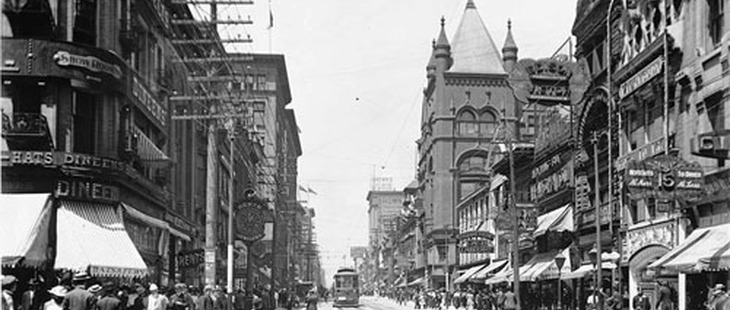
(City of Toronto Archives) Strangely, no one remembers the great streetcar debate of the 1890s. Back then public transit was a six days a week thing and most people worked every day except the Sabbath. Without those employees coming into downtown on Sunday, service on the Lord’s Day was an otherwise an unprofitable venture–and, for the private operators, this was all that mattered. And so, for most of the 1800s, you were walking if you wanted to get somewhere after church. But this is a story about saloons not streetcars. The thing is, it was thought then that the patronage of the former had something to do with the availability of the latter. By 1890 Toronto had hit critical mass. With some 200,000 souls, what was once a colonial backwater now boasted all those things that make a city: art galleries, leisure, entertainment, bars, restaurants, slums, structural unemployment, gambling, brothels, a measure of diversity, unions and churches. To be sure, each had antecedents in early Toronto but now, for the first time, the city was reaching metropolitan standards; it functioned as a whole, with specific neighborhoods and districts to boot. There were things to do in the city on Sundays, places to go on the weekend. Slowly, the calls for Sunday transit service began to build. The problem was Toronto’s Ward neighbourhood, or St. John’s Ward as it was known even before that. Bounded by Yonge and University, College and Queen, it was home to the city’s brothels and bars, its underground economy. It was where one found Toronto’s id. Despite the dominant conservative and protestant social mores of the day, or perhaps because of them, the Ward thrived. Today it’s the haunt of civil servants and hospital workers; back then it’s where one went to find a saloon. It was here, said C. S. Clark, author of Toronto the Good, that one could be exposed to Toronto’s criminal underbelly. So appalled, he devoted two chapters to the Ward’s ‘streetwalkers’ and bawdy houses, though most prostitution’s operation was, in fact, limited to the saloon. Toronto’s saloons, packed into the Ward, were democratic spaces. The city’s elite went there to drink and play away from the judging eyes of neighbour and priest. In the saloon, the working class took their reprieve from the long day of toil. Though women were generally not allowed in bars, they were often allowed, at minimum, to get some booze out back. Samuel Gompers, future President of the American Federation of Labour, offered that all men appeared on equal footing in the saloon: conversations, he said, “had a peculiar freedom from formality that engendered good fellowship and the exchange of genuine intimacies.” Then there was this fixture of the time’s drinking culture: it was more customary then for people would treat others, maybe the whole bar, to free drinks. (City of Toronto Archives) Many of the Ward’s saloons openly broke Toronto’s Sunday closing law. Business was too good. Toronto had one of the highest patron-to-bar ratios in North America. With only 150 saloons within city limits, many were bankrolled by brewers who wanted to ensure that their product was always available to customers. Some saloons augmented their income by serving opium. Processed legally in Victoria B.C., Toronto’s Ward neighbourhood was an important way station in the North American opium trade. Opium dens began springing up in the Ward, but also on Parliament and Jarvis streets. To forestall the efforts of the police, these saloon/dens were heavily fortified; the front door bolstered with multiple deadbolts and and so thick, one journalist commented, no axe could have fully penetrated it. Inside, the rooms were small and cramped, but that didn’t matter because there was a ready supply of “heathens and Christians eager to patronize them.” Ready access to sex, a communal drinking culture, foreign drugs, and crime made the Ward the ideal place for Toronto to release some of its repressed libidinal desires. No doubt, more than a few citizens would have been eager to get down there on their day off. But the puritans would have none of it: the streetcars, they said, shall not run. On Sunday, of all days, it shouldn’t be made more easy for someone to traverse the boundary from legitimate to illegitimate, from church to sin, and ultimately: from home to St. John’s Ward. Two citywide referendums were held on the issue and twice the voting public confirmed that there should be no Sunday transit service. It wasn’t until 1897 that the ‘yes’ contingent won, by a mere 900 votes. But things worked out favourably for the puritans in the end. At the turn of the century the New York Times reported that all these new streetcars in North American cities were actually affecting the saloon negatively. It turned out that men who walked, whether together or alone, were more likely to wind up in a bar. But the streetcar, it just took you home.














